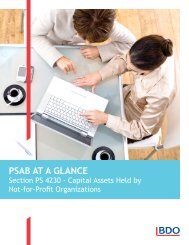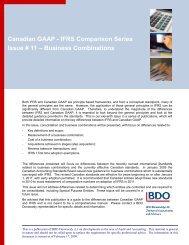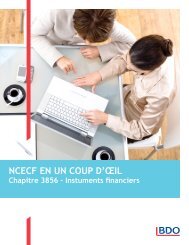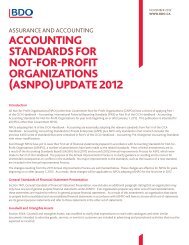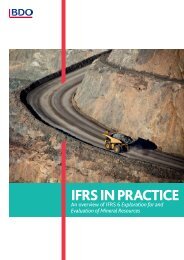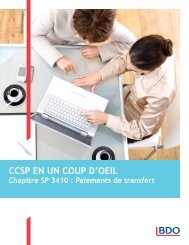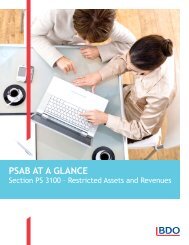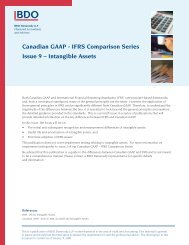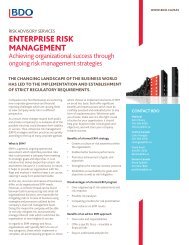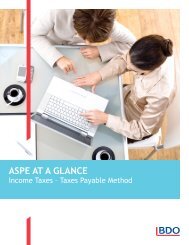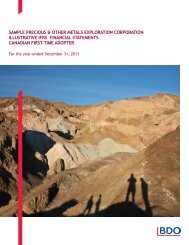need to know / leases - project update - BDO International
need to know / leases - project update - BDO International
need to know / leases - project update - BDO International
Create successful ePaper yourself
Turn your PDF publications into a flip-book with our unique Google optimized e-Paper software.
22 LEASES - A PROJECT UPDATE<br />
REASSESSMENT OF THE DISCOUNT RATE<br />
The discount rate would not be reassessed if there was no change in the lease payments. The discount rate would be<br />
reassessed when the changes below were not reflected in the initial measurement of the discount rate:<br />
1. When there is a change in lease payments that is due <strong>to</strong> a change in the assessment of whether the lessee has a significant<br />
economic incentive <strong>to</strong> exercise an option <strong>to</strong> extend a lease or <strong>to</strong> purchase the underlying asset.<br />
2. When there is a change in lease payments that is due <strong>to</strong> the exercise of an option that the lessee did not have a significant<br />
economic incentive <strong>to</strong> exercise.<br />
The revised discount rate would be the spot rate at the reassessment date (that is, the rate that would be applied <strong>to</strong> a new lease<br />
that was entered in<strong>to</strong> on that date), which would then be applied <strong>to</strong> the remaining lease payments (for example, the remaining<br />
payments due in the initial lease plus the payments due during the extension period or upon exercise of a purchase option).<br />
SHORT TERM LEASES<br />
A short-term lease is a lease that, at the date of commencement of the lease, has a maximum possible term, including any<br />
options <strong>to</strong> renew, of 12 months or less. Cancellable <strong>leases</strong> would meet the definition of short-term <strong>leases</strong> if the initial noncancellable<br />
period, <strong>to</strong>gether with any notice period, is less than one year.<br />
A lessee would not be required (but would be permitted) <strong>to</strong> recognise lease assets and liabilities arising from short term<br />
<strong>leases</strong>. For those <strong>leases</strong>, assuming the lessee did not elect <strong>to</strong> recognise assets and liabilities arising from them, lease<br />
payments would be recognised in profit or loss on a straight-line basis over the lease term, unless another systematic and<br />
rational basis was more representative of the time pattern in which use is derived from the underlying asset. It is not yet clear<br />
whether the option <strong>to</strong> recognise lease assets and liabilities arising from short term <strong>leases</strong> would <strong>need</strong> <strong>to</strong> be applied <strong>to</strong> all of<br />
those <strong>leases</strong>, or whether an entity could choose which of its short term <strong>leases</strong> <strong>to</strong> capitalise.<br />
A lessor would be permitted <strong>to</strong> elect, as an accounting policy for a class of underlying asset(s), <strong>to</strong> account for all short-term<br />
<strong>leases</strong> by not recognising lease assets or lease liabilities and by recognising lease payments in profit or loss on a straight-line<br />
basis over the lease term, unless another systematic and rational basis was more representative of the time pattern in which<br />
use is derived from the underlying asset. This would result in an accounting approach which would be similar <strong>to</strong> operating<br />
lessor accounting in accordance with IAS 17.<br />
SALE AND LEASEBACK TRANSACTIONS<br />
The first step would be <strong>to</strong> determine whether a sale had occurred, which would be assessed using the control criteria set<br />
out in the revenue recognition <strong>project</strong>. If no sale had taken place, then the entire transaction would be accounted for as a<br />
financing arrangement.<br />
When a sale of an asset has occurred and then the asset is leased back, the transaction would be accounted for as a sale and<br />
then a leaseback. If the consideration was at fair value, the gains and losses arising from the transaction would be recognised<br />
when the sale occurred. If the amount of consideration was not fair value, the assets, liabilities, gains and losses recognised<br />
would be adjusted <strong>to</strong> reflect current market rentals.<br />
The seller/lessee would adopt the whole asset approach in a sale and leaseback transaction. This means that in a sale and<br />
leaseback transaction, the seller/lessee sells the entire underlying asset and <strong>leases</strong> back a right-of-use asset relating <strong>to</strong> the<br />
underlying asset.



